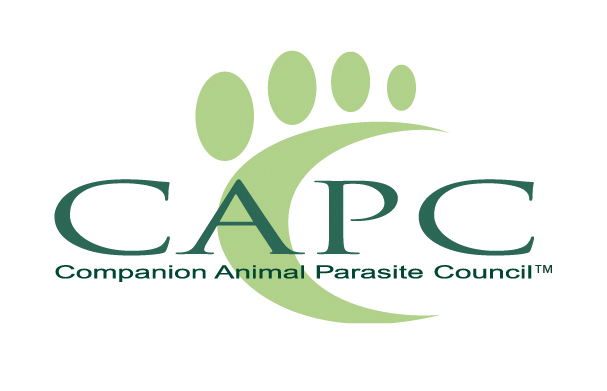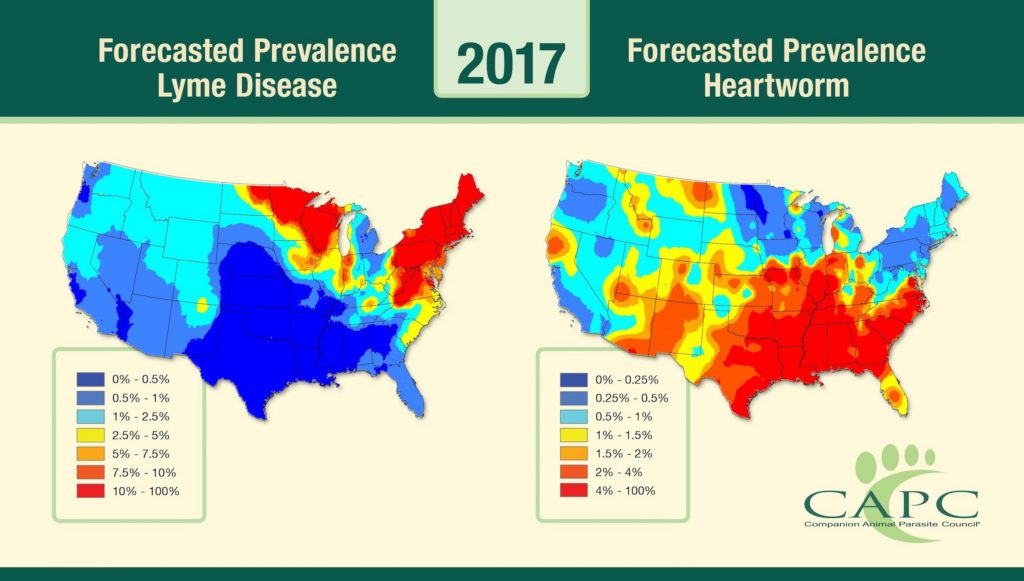Craig Prior is the new president of the Companion Animal Parasite Council (CAPC) at just the right time. Prior is a practitioner of some 30 years, he’s seen many changes in practice and now is set out to help deliver the organization’s core message to get every pet tested and protected. As evidence emerges of heartworm increasing nationwide. Goodnewsforpets.com writer Kim Campbell Thornton recently caught up with him. The new CAPC maps, a new website and new CAPC mosquito control guidelines have come out, so there was much to discuss!
What led you to become a veterinarian, and how did you end up in Tennessee from Australia?
I wanted to do something in the medical field and I liked animals, so it seemed to match. I graduated from the University of Queensland in Australia, but while I was in school I took a gap year and I was one of 24 people chosen to represent Australia at the World’s Fair in Knoxville in 1982. While there I met my future wife. We started going out together and flying back and forth to see each other and got married here. We went back to Australia, and then came back over here so she could finish her schooling and after that we just stayed.

I. Craig Prior, BVSc, CVJ, President of Companion Animal Parasite Council (CAPC)
How has veterinary medicine changed in the 30 years you’ve been practicing?
Oh, my goodness. Dramatically. Dogs have gone from the backyard to the bed and the couch; they’ve gone from being just a possession to being a true family member. CT scans and MRIs are now commonplace; and technology and procedures are keeping pace with the human side. It’s been quite an interesting life to say the least, just to see all these changes. It’s been a good profession to me.
Tell us about some of your most interesting or unusual cases.
I’ve really seen it all. I’ve done exotic medicine, so I’ve treated a couple of kangaroos and other interesting animals. Earlier in my career here, I saw a case of strychnine poisoning that people were puzzling over. I had a hunch and clapped my hands and the dog seized. That’s a sign of strychnine poisoning, so we were able to treat for that and get the dog better. I had a more amusing case where a farmer called me and said ‘Are you the Australian vet?’ Yeah. ‘Well, do you know much about sheep?’ Yeah, a lot. ‘Well, one of my ewes broke her leg. What do I do?’ ‘Shoot it and eat it. That’s what we do in Australia.’ ‘But Ethel’s my favorite.’ ‘Oh, my goodness, you named her. Bring her in; we’ll fix it.’ That’s the first time I had to do something like that for a sheep. He only had 18, and they were his pets (Each Australian farmer has thousands).
What are some of the challenges you face as president of the Companion Animal Parasite Council?
Our goal is to have every pet tested and every pet protected. Thereby you’re not just protecting the pets, you’re protecting the family members as well. Unfortunately we’re seeing heartworms spread. Over the past five years, we have closely observed the CAPC parasite prevalence maps and heartworm has shown up in counties we haven’t see it in before and positive tests have continued to rise in other counties. In fact, since 2012, CAPC has seen an additional 10,000 cases each year across the USA as a whole.
We have very good products that do a good job and are a lot more convenient for people to use. But even so, we’re seeing heartworm disease incidence increase. There are two main factors for that. One is the compliance issue: people just don’t remember to give preventive, and they don’t give it year-round like CAPC recommends. The other issue is we’re starting to see some resistance to the products showing up, so that’s a real concern. If we can get everyone to give their pets once-a-month products every month all year round all their lives, we could really see the incidence of heartworm reduce.
A lot of people don’t realize that mosquitoes spread heartworm. Seventy species of mosquitoes can carry microfilaria and spread heartworm disease. Cats are prone to heartworm disease as well. A lot of people don’t think about that either. About 25 percent of indoor cats are positive for heartworm.
What do you say to pet owners who are fearful that parasite preventives can harm their pets?
First thing, there’s no medication that you can guarantee to be 100 percent effective or 100 percent safe for 100 percent of all pets. The same is true for humans medication. But there have been millions and millions of doses used, and the safety is incredibly high. Depending on the product, there are some precautions that you need to do that your veterinarian is aware of. Veterinarians are able to advise you on the safest product to use for your particular pet. But if it comes down to ‘I don’t want to give this to my dog because I’m scared of the effects of it,’ well, the damage that heartworms do to your pet are far greater than any risk that a medication could be to your dog.
Do you think the emergence of Zika has helped to raise awareness of other mosquito-borne diseases?
Absolutely. Anything that affects humans from a vector basis definitely helps our awareness because people have been worried, ‘Can my dog get Zika?’ People ask the question and it’s a good way of opening a conversation about what vectors can affect your pet and what diseases they can spread.
 Transporting dogs from the south to other areas of the country helps to get them adopted, but it also helps to spread heartworm disease. What are some of the precautions that rescue groups and adopters can take to prevent that?
Transporting dogs from the south to other areas of the country helps to get them adopted, but it also helps to spread heartworm disease. What are some of the precautions that rescue groups and adopters can take to prevent that?
One of the things they can do is every dog should be tested. If you find a positive dog, either treat it first or get it set up to be treated as soon they reach their destination. There’s two papers now, published by Dr. John McCall, a parasitologist at the University of Georgia, showing that applying a product which has insecticidal and repellent properties toward mosquitoes, was 100 percent effective at preventing the transmission of microfilaria from infected dogs to the mosquitoes. One would hope that by applying this to all these shelter dogs, you may have a community effect because you’re preventing those dogs from being able to spread it to mosquitoes and thereby expose other dogs. Now that is not the only solution; it’s not the only thing that should be done, but it’s a good temporary measure with these shelter dogs to help decrease the spread of heartworm disease.
The second phase of his study was looking at the spread of infective L3 heartworm larvae from infected mosquitoes to dogs. They used a resistant strain of heartworms to really challenge the product. In the study they had four groups: a control group, the topical product only group, a macrocyclic lactone-only group, and a macrocyclic lactone with the topical product group, and the latter was the only group where there was no development of adult heartworms. So using products with proven repellant and insecticidal properties against mosquitoes, you’re adding another layer of defense, another layer of protection.
If you look at the World Health Organization, they have always recommended vector control. Over 50 percent of their efforts toward preventing malaria have been controlling the mosquito. It’s been extremely effective. We’re just applying that same type of technology now that we’ve got some good products to add that other layer of protection by controlling the mosquito to heartworm prevention for dogs and it’s proven to be very, very effective. Everyone with dogs in a heartworm area should be using a topical product with mosquito repellant and insecticidal properties with heartworm prevention [program]to help ensure that your dog is protected fully.
What are your goals for CAPC during your presidency?
It really comes back to every pet tested and every pet protected. We provide the guidelines that veterinarians use, we provide the maps that veterinarians use, that consumers use, we provide forecasting so they can see what’s going on. Our goal is to increase awareness. Parasites are dynamic and ever-changing, and they’re very adaptable so we have to keep up with them, keep on top of them. Our goal is to provide the most up-to-date, the best guidelines for veterinarians, for consumers, to provide the tools to help consumers and veterinarians to really provide the best care for their pets, their patients and their families. We have two websites: capcvet.org is the scientific site. It’s for consumers as well, but it’s mainly geared to veterinarians and technicians, and then the consumer site, which also has our maps, is petsandparasites.org.
 What are the most significant changes in the new CAPC guidelines?
What are the most significant changes in the new CAPC guidelines?
We have mosquito guidelines now; that’s brand-new. We’re trying to increase awareness of vector control. We just finished updating heartworm guidelines including vector control. We’ve added more mapping, so we have maps for the different tick-borne diseases, we have them for Lyme, ehrlichia, anaplasma; we have internal parasites, hookworms, roundworms, whipworms, we just added giardia because that’s such a huge problem for so many pets; we’ve added feline antibody and feline antigen to the heartworm maps; we’ve also added feline leukemia and feline AIDS incidence; even though they’re not parasites, they’re infectious diseases but could they have an effect on the incidence of certain parasites?
We’re looking to add more maps as well, so in the coming year we’ll hope to have some more maps up for other diseases that people are concerned about. We’ll be able to add soon a local forecast for one month in advance. You’ll be able to see what’s going on in your local county on a month-by-month basis. It’s incredibly relevant because it’s in your backyard, it’s local, it’s now, and that’s what people want to see. We’re really getting good information out there so people can understand what their risks are. We’ll continue to do that and improve on it, improve our forecasting, and forecast other diseases and parasites as well.
When people look at our maps, if they live in an area where they’ve already have Lyme disease, if there’s an incidence of 5 percent or higher in your county, CDC has a paper out that shows a direct correlation between a 5 percent or higher incidence in dogs and humans developing Lyme disease. They can look at our maps for their county and say ‘Oh my goodness, it’s 6 percent, I need to be doing a better job of tick control and a better job of it for my dog as well.’
Tell me about your pets.
Our ranks have thinned a little bit. A couple of years ago we had two dogs, two cats, two guinea pigs and a pet chicken. We’re down to just one dog and two cats. Our 5-year-old dog goes everywhere with us. She’s brilliant, a fantastic dog, really the best dog we’ve ever had. She’s incredibly active and lively. We’re always out hiking, mountain biking, paddleboarding; she does it all. She jumps on the paddleboard with us, swims between the two paddleboards, goes mountain biking with me, goes hiking, whatever we do, she does. She’s a delight to have around. Pets just add so much to our lives; they enrich us so much. It’s unconditional love, which is really nice. They just don’t live long enough; that’s the only problem. But they teach us a lot and they don’t need to live as long as we do because they’ve already got life worked out.
To learn more about CAPC visit capcvet.org and their new website for pet parents, petsandparasites.org.
Connect on with CAPC on Twitter: @capcvet or on Facebook: Companion Animal Parasite Council

1 Comment
I am proud of my son.